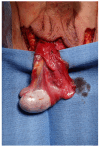Tissue Options for Construction of the Neovaginal Canal in Gender-Affirming Vaginoplasty
- PMID: 38792302
- PMCID: PMC11122258
- DOI: 10.3390/jcm13102760
Tissue Options for Construction of the Neovaginal Canal in Gender-Affirming Vaginoplasty
Abstract
Gender-affirming vaginoplasty (GAV) comprises the construction of a vulva and a neovaginal canal. Although technical nuances of vulvar construction vary between surgeons, vulvar construction is always performed using the homologous penile and scrotal tissues to construct the corresponding vulvar structures. Therefore, the main differentiating factor across gender-affirming vaginoplasty techniques is the tissue that is utilized to construct the neovaginal canal. These tissue types vary markedly in their availability, histology, and ease of harvest and have different advantages and disadvantages to their use as neovaginal lining. In this narrative review, the authors provide a comprehensive overview of the tissue types and associated operative approaches used for construction of the neovagina in GAV. Tissue choice is guided by several factors, such as histological similarity to natal vaginal mucosa, tissue availability, lubrication potential, additional donor site morbidity, and the specific goals of each patient. Skin is used to construct the neovagina in most cases with a combination of pedicled penile skin flaps and scrotal and extra-genital skin grafts. However, skin alternatives such as peritoneum and intestine are increasing in use. Peritoneum and intestine are emerging as options for primary vaginoplasty in cases of limited genital skin or revision vaginoplasty procedures. The increasing number of gender-affirming vaginoplasty procedures performed and the changing patient demographics from factors such as pubertal suppression have resulted in rapidly evolving indications for the use of these differing vaginoplasty techniques. This review sheds light on the use of less frequently utilized tissue types described for construction of the neovaginal canal, including mucosal tissues such as urethral and buccal mucosa, the tunica vaginalis, and dermal matrix allografts and xenografts. Although the body of evidence for each vaginoplasty technique is growing, there is a need for large prospective comparison studies of outcomes between these techniques and the tissue types used to line the neovaginal canal to better define indications and limitations.
Keywords: gender-affirming surgery; gender-affirming vaginoplasty; intestinal vaginoplasty; penile inversion vaginoplasty; revision vaginoplasty; robotic-assisted peritoneal flap vaginoplasty; vaginal reconstruction.
Conflict of interest statement
The authors declare no conflicts of interest.
Figures



References
-
- James S.E., Herman J.L., Rankin S., Keisling M., Mottet L., Anafi M. The Report of the 2015 U.S. Transgender Survey. National Center for Transgender Equality; Washington, DC, USA: 2016.
-
- Gillies H.D., Ralph Millard D. The Principles and Art of Plastic Surgery. Little, Brown and Company; Boston, MA, USA: 1957.
-
- van der Sluis W.B., Tuynman J.B., Meijerink W.J.H.J., Bouman M.B. Laparoscopic Intestinal Vaginoplasty in Transgender Women: An Update on Surgical Indications, Operative Technique, Perioperative Care, and Short- and Long-Term Postoperative Issues. Urol. Clin. N. Am. 2019;46:527–539. doi: 10.1016/j.ucl.2019.07.007. - DOI - PubMed
Publication types
LinkOut - more resources
Full Text Sources

